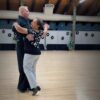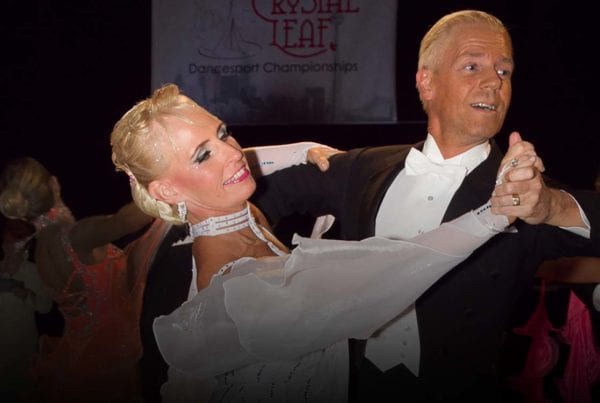The Rumba is referred to as the “Dance of Love.” Romantic and sensuous, today’s International Style Rumba is essentially a story of the lady seducing the man she is dancing with. But this dance has a long and complex history. Parts of its development were even known as the Rumba Wars. An interesting background for such a romantically-linked dance!
Nobody knows exactly what the first Rumba steps were. But we do know that there was a battle in England over the issue of how the Rumba could be developed. According to Brigitt Mayer, perhaps the world’s foremost authority on the history of the ballroom dances, “even the biggest dance authorities are undecided as to what was danced first: the box [that has been retained in the American Rhythm Rumba], or the Mambo basic [that has continued on in the International Style Rumba].” The box step was danced in the 1930’s in the United States, then made its way to Paris under the influence of teacher Monsieur Pierre and standardized for the British dance style. After Pierre and Dorothy Lavelle went to Cuba in 1947 they further developed the Rumba with additional steps that moved away from the limitations of the box, now referred to as “International” style.
In the early 1970’s the top dancers competed in both styles. But many felt that the box step version limited their options for creative choreography and Lavelle’s new steps started catching on across Europe. In Germany this battle over the box style and the “new” style led to the Rumba Wars that were eventually decided by a conference featuring Nina Hunt and Dimitri Petrides influencing strongly in favor of the newer approach.
Although the Rumba originated as a Latin American dance and was born from Cuban movements like the Son and Danzon, the British style was very stiff and formal, keeping the dance from truly embracing its Latin roots. The British ruled the dance world in the 1950’s. Walter Laird, one of the most prominent Latin teachers in the world, took on a massive project to write down the steps and technique in great detail, creating a standardized approach to teaching and dancing the Rumba. His work became legend around the world. But this also served to further keep the dance from realizing its potential for hip action and body isolation. Rumba music was very fast by today’s standards, with tempi roughly the same as today’s Cha Cha.
Fortunately, American dancers who didn’t want to be limited by these static approaches to the Latin dances began experimenting with body isolation and developed some remarkable technique.
Wolfgang Opitz and his partner Evelyn Hadrich, working alone with no coaches, were influenced by the Latin American clubs that were all the rage in the late 1950’s and early 60’s. Wolfgang loved the music of Tito Puente and other Latin American bands playing at clubs like the Palladium in New York. He and Evelyn were really the first couple to develop hip action in the Rumba. They would put on a show and dance with the English style then announce, “This is how we really feel it should be danced,” and then demonstrate their version. The crowd would go wild.
But teachers, particularly the British teachers, didn’t want this new hip action. Other American couples led by great influencers like Bobby Medeiros, Vernon Brock and Sam Sodano also embraced the new style and would take it to England in competition. Rudolf Trautz told legendary coach Nina Hunt that he couldn’t even imagine dancing the Rumba without hip action as she was requesting. When Vernon Brock and Beverly Donahue came to Blackpool in 1971 their practice session caused the entire floor to stop just to watch this mesmerizing new Latin style. To the rest of the field, it looked like a revolutionary mix of pure Latin American and West Side Story. It shook all of Latin dancing to the core and ushered in a whole new way of thinking of these dances.
You can learn more about the people who shaped the history of the Rumba and other dances in Brigitt’s excellent book Ballroom Icons.
The Rumba continues to develop in beautiful ways. The International Style Rumba places great emphasis on using internal body rotation to create power for turns and light and shade in choreography as well as musicality. Music has been slowing down, with today’s International Rumba tempo closer to Bolero than Cha Cha. While some aspects of modern choreography tend to place too much emphasis on picture lines and not enough on dancing for my taste, it continues to be a beautiful expression of a love story when danced with passion and quality.













Thanks George wonderful history lesson.